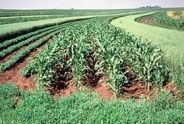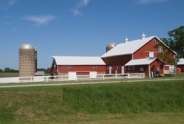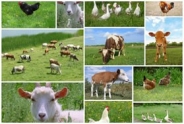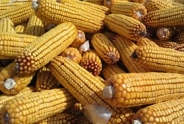A Real Life Reminder for Farm Safety Around Animals!
Katelyn Walley, Business Management Specialist and Team Leader
Southwest New York Dairy, Livestock and Field Crops Program
If you've tried to email or call me in the past month, you probably received an automatic "out of office" message and an extended wait for a reply! I have been using up all of my sick time to deal with a long concussion recovery - caused by, you guessed it, an unfortunate farm accident.
In a classic case of "do as I say, not as I do," I was ear tagging cows on our farm using less than ideal animal restraints. One cow decided to swing her head in just the right way to catch me on the forehead with her jaw! This resulted in a bad concussion and whiplash with symptoms like nausea, inability to focus, sensitivity to light and sound, issues with speech and vision, and general exhaustion. I was out of commission for a couple of weeks and am still working through lasting symptoms more than a month later.
This incident was a stark reminder for myself and my family about just how important farm safety is and should be. Farming is an inherently risky business, and we've all heard about some of the truly shocking accidents that have hit our agricultural community in just the past few years.
When working with any type of livestock or equipment, it's key to consider safety to keep yourself, your farm family, employees, and animals safe. On average from year to year, one in every four farm accidents involve animals. Below are some farm safety reminders for working with animals on the farm.
1. Animal Behavior is instinctive AND learned. For example, cows can learn to be calm around humans and wear a rope halter without too much fuss. However, natural instinct when experiencing something new (ear tagging) will be to react in "fight or flight" mode which will cause sudden movements. Be prepared for sudden movements and don't trust animals just because they're the kind ones in the herd.
2. Consider depth perception and color blindness. Many animals have different vision than we do. This results in big reactions to blind turns, color changes, gaps in flooring and pens, and quick movements (think - fans, children, equipment, etc.). Go through your housing and handling facilities looking out for areas that might cause hang ups when working with animals. Always operate in areas with adequate lighting.
3. Facilities need to be up to par. We can oftentimes prevent accidents by thoroughly preparing our animal handling facilities. In addition to the lighting mentioned above, there are other things to check on periodically. Look for any loose boards, gates, panels, or other handling areas that might need some new screws, bolt tightening, or replacement. Watch for any sharp projections (aka - that nail that never got pounded in all the way). Add traction to areas that get slippery and reduce blind spots.
4. Remember the Flight Zone. We've all heard about cow flight zones, and often use them to our advantage to calmly and safely move cattle when necessary. However, remembering that cows can't see directly behind them, have varying flight zones, and react suddenly to sounds and movements will keep everyone safe.
5. Ask for help. Oftentimes, we're put into situations where we have to handle animals alone. However, having an extra person around is always better! More help, and clear communication, will allow for extra time and safer handling.
6. Plan for Human Exits. When working animals, we tend to avoid working in the center of the group or facility to limit the chance for trampling, kicking, and headbutting. However, working in corners and against walls can also lead to getting pinned. Plan for space with animal handling facilities and know how you can get out of a situation quickly if needed.
7. Be Patient, Kind, and Consistent. Animals (and humans, too) are creatures of habit. Keeping activities consistent and calm will help everyone involved. Allow animals for space and time to get acclimated to new areas, new people, and new routines. Keep the barn a calm environment by reducing loud and sudden noises and avoiding overcrowding. Handling animals humanely regardless of their age or demeanor. Animals will remember poor animal handling situations for the rest of their lives and will continue to react strongly. At the herd level, calm and consistent handling will lead to calm and consistent animals.
One way you can offset the cost of farm safety improvements for your farm is through the John May Farm Safety Fund. This program, managed through the Bassett Healthcare Network's New York Center for Agricultural Medicine and Health, is available to all New York State farms with annual farm incomes of $10,000 to $350,000.
Farms are eligible to apply for matching funds up to $5,000. Funds are awarded on a rolling basis and only require a simple application, a farm visit from program staff, and monthly project updates. Farms right here in SWNY have received funds from the John May Farm Safety Fund to install cattle squeeze chutes, purchase animal handling equipment, redesign farm working facilities to improve safety, and more.
Ironically enough, our farm was awarded funds from the John May Safety Fund to purchase and install a cattle handling system a few months ago. We just haven't "had the time" to get everything together, and this accident was a great reminder and motivator! ▪
Resources that we used in preparing this article:
· Penn State Extension Animal Handling Tips: https://extension.psu.edu/anim...
· John May Safety Fund: https://www.nycamh.org/program...
Upcoming Events
WNY Pastureland Conversion & Soil Health Field Day
July 16, 2025
Middleport, NY
Join American Farmland Trust for the Western New York Soil Health Field Day on July 16, 2025, at Zeliff Farm in Middleport, NY, from 9:00 AM-3:15 PM. Learn about pasture conversion, soil health benchmarking, biochar in grazing systems, and best grazing practices. Plus, enjoy hands-on demos with the NY Soil Health Trailer, drones, and cover crops! Check out the attached agenda for more information about the field day and REGISTER HERE. Zeliff Farms is a regenerative beef operation who has recently partnered with AFT on outreach and education to farmers including learning circles and evaluating biochar effects on soil health.
IPM Strategies to Protect Corn and Soybean Seed in NY
July 30, 2025
Hamburg , NY
SWNYDLFC and Cornell IPM are hosting a grower meeting to discuss integrated pest management strategies for protecting corn and soybean seed in New York.
FAMACHA Training for Sheep and Goat producers in Woodhull NY
August 13, 2025 : FAMACHA Training in Woodhull
Woodhull, NY
Join us for a discussion and hands-on training for internal parasite integrated pest management in sheep and goats. Certification is available to all students participating in the workshop.
Announcements
No announcements at this time.





